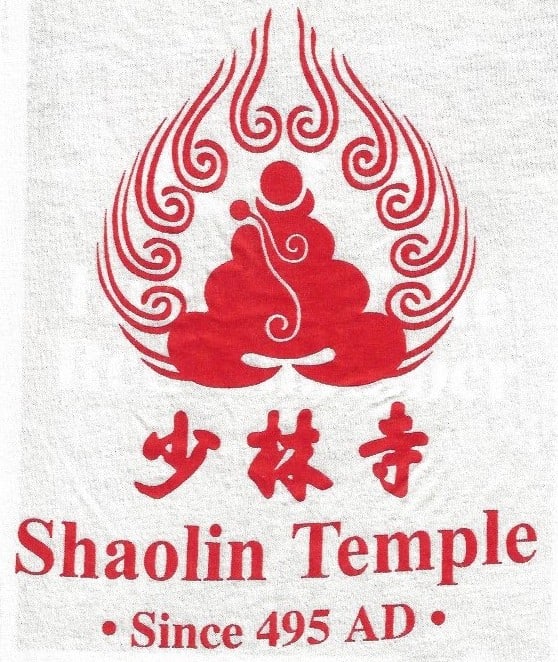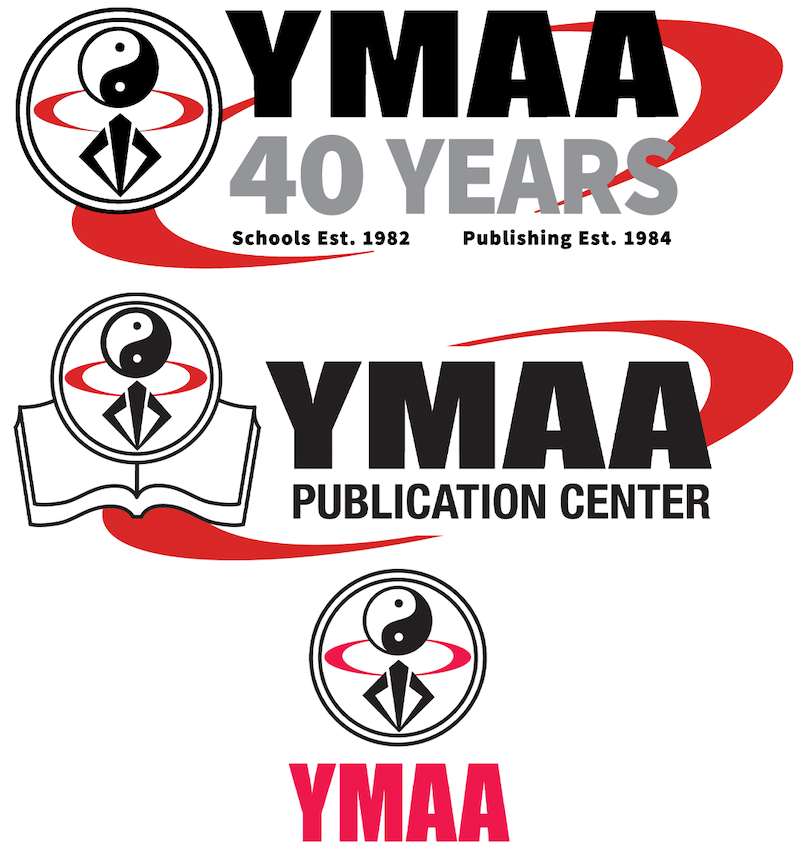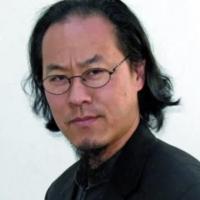A special emblem was created in honor of the 40th anniversary of YMAA to pay homage to this significant milestone. The essence of the emblem is the same as the standard, but this acknowledges the founding year with the distinction between the YMAA school, first established in 1982, and the publishing center, which began two years later.
The YMAA Publication Center logo is slightly different, adding an open book as a pedestal for the emblem. The schools and the publication center are intimately connected, yet divergent. For example, YMAA Publication Center offers a book on sumo; but sumo is not a regular part of the curriculum at the more than fifty affiliated YMAA schools. Since this anniversary is for the schools, the anniversary logo omits the book pedestal. Perhaps in 2024, we’ll celebrate the publication center’s 40th and make another anniversary emblem, but that’s two years from this writing.
An explanation of the symbolic meaning of the emblem can be found in the ‘About YMAA’ section on early YMAA DVDs. Given the anniversary, it’s worth reexamination and some further exploration. The meaning of symbols can change over time as we’ll discuss later. The circular YMAA emblem has three symbols at its core: the yin yang, the red oval, and the trident.
The Yin Yang
Countless martial arts schools incorporate the yin yang within their emblem. It’s a fundamental concept in the martial arts, particularly taijiquan. Dr. Yang specifies that when used in the context of taiji (tai chi) *, it should be properly called the ‘Taiji Yin/Yang.’
Taiji is a Daoist concept first and foremost. It’s a philosophy and a perspective. The yin yang is a graphic representation of this. One of the earliest mentions of yin and yang occurs in the Yijing (a.k.a. I Ching) – the book of changes – and that is believed to have been published in the late 9th century BCE. The practice of taijiquan as a martial art is a physical expression of this Daoist philosophy, to which the concept of yin and yang is critical.
The power behind the yin yang is that the symbol, like the concept, is balanced. It is easily and universally understood graphically. A deep dive into the origins and symbology behind the yin yang can get really heady really quickly, so let’s just leave it here. If you want to know more, consult the numerous taiji books available through YMAA.
The Circles
The red circle symbolizes the unification and harmonization of the internal and external. This idea of internal and external is an incarnation of yin and yang, again as expressed in the martial arts. In a gross simplification, we can view the internal as spiritual and the external as physical. Some interpret this to mean that internal arts are powered by qi while external arts are driven by the anatomy – hands and feet, elbows and knees, shoulders and hips, head and torso. This perspective on internal versus external is reminiscent of Descartean mind and body distinction. Descartes argued the mind is indivisible, but the body can be split into parts. Remember the root word of anatomy comes from the Latin ‘anatomia’ and the Greek ‘anatomē,’ which becomes ‘anatemnein’ meaning ‘to cut up,’ as in split into parts. Perhaps we can extrapolate the notion of indivisibility to internal arts.
Some contemporary scholars have put forth the notion that internal and external are nationalistic metaphors. Internal schools are indigenous to China. Whether the cradle of taiji is believed to be Wudang mountain or Chen village, both are in the heart of China. The Daoist foundation of taiji is firmly grounded in China. External arts are imported. Legend attributes the foundation of Chinese martial arts to Shaolin and Bodhidharma. This is Buddhist and Buddhism was imported from India. For martial artists entrenched in the less geographic notion of internal and external, this is a challenging notion. But for the open minded, it’s an intriguing perspective to explore intellectually. Like I said, this gets really heady really quickly. Such is the nature of symbolism.
The outer circle is more than just a frame. Symbolically it represents the unification of the whole world into one. Global unity is something that YMAA is working towards with its fifty-plus schools spread across sixteen countries. Martial arts crosses cultures or I wouldn’t be writing this in English, nor would YMAA be publishing in it. And Dr. Yang’s books have been published in many other languages including French, Italian, Spanish, Polish, Czech, Dutch, Bulgarian, Russian, Hungarian, Portuguese, Croatian, German, and Farsi.
The Trident
The YMAA Trident is the most unique feature of the emblem and what I really want to explore here. It’s the Buddhist nod, and being Buddhist, as well as a disciple of Shaolin Temple, this has a lot of personal meaning to me. The Trident is my favorite part of the YMAA emblem. It’s unique and provides a contrasting balance with the yin yang, just as Daoism and Buddhism informs much of the qigong practice.
The symbol was created by Dr. Chen, Li-Fu at Purdue University for Dr. Yang in 1975. Despite its 1500+ year history, Shaolin did not have an internationally recognized symbol back in the seventies. At that time, the Shaolin Temple was still in a dilapidated state in the wake of the Cultural Revolution. It wasn’t until after Deng Xiaopeng launched the Open Door Policy in the late seventies that restoration began. Ironically, if you do an image search of ‘Shaolin symbol’ on the web, you’ll get a lot of yin yangs. But as we discussed previously, that’s a popular overgeneralization of Shaolin. Shaolin Temple is Buddhist, not Daoist.
Those early YMAA video descriptions attribute the swastika as the original Shaolin symbol, although this is a bit nebulous. The swastika is a Buddhist symbol used at Shaolin but not exclusive to it. In one of the most savage examples of cultural appropriation ever, Hitler adopted the swastika as the emblem of Nazis. Since then, it is associated with fascism in the Western world. However, like Buddhism, the swastika traces back to India.
In Buddhism, the swastika symbolizes the wheel. Swastikas can be found in many time-honored holy places throughout India and China. They are worked into the architecture at Shaolin Temple, as they are in many Chinese Buddhist temples. Shaolin Temple did use it occasionally. I had a Shaolin Temple tie clasp that was a gold swastika on a red field. I got it as a novelty souvenir, but I don’t wear it because it put out the wrong message here in the USA. Clearly a swastika would be completely inappropriate on the YMAA emblem. And Shaolin Temple hardly uses it anymore either, being aware of how its meaning has changed internationally. Ironically, it's an expression of the wheel in motion. All things are impermanent, even the meanings of your symbolism.
A joined trident has a lot of symbolic meaning. Buddhism is rooted in the three treasures – the Buddha, the Dharma, and the Sangha. Dharma is the nature of reality regarded as universal truth as taught by the Buddha, or more simply put, the teachings. Sangha is the Buddhist community. It’s all about the transmission – the teacher, the teachings, and the taught. Joining these together is a sign of unification as well as the transmission of legacy.
China has another venerated trinity, a philosophical one: Daoism, Buddhism, and Confucianism. These are the three most prominent perspectives of China and elements of each have cross-fertilized each other for centuries. Intriguingly enough, one of the symbols of Shaolin Temple today is from an ancient stele in its vast collection of monuments. Titled as ‘The Primordial Unity of the Three Religions and the Nine Schools’ this stele is dated 1565. The image on the stele is of a circular figure with a Daoist bandana, Buddhist shaved pate, and a Confucian cap. Like the YMAA circle and trident, it is symbolic of unity.

The joined trident reminds me of the Chan Zhang (禪杖). This is a special kind of walking staff used by senior Buddhist monks. It has an unusual staff head that looks something like a bird cage. This is a variation of the vajra, which means ‘indestructible’ in Sanskrit. It is sometimes translated as ‘diamond’ (indestructible gemstone) or ‘thunderbolt’ (indestructible force). The vajra is a symbol used in Hinduism, Jainism, and Buddhism. Hindus believe the vajra is the most powerful weapon in the universe. Some theorize that it evolved from a joined trident, not unlike the YMAA trident. In this context, three prongs represent unity, harmony, and compassion.

For the Chan Zhang, it is often the joining of eight prongs. This represents the Eightfold Path: right view, right resolve, right speech, right conduct, right livelihood, right effort, right mindfulness, and right samadhi (intense concentration from meditation). While it is typically used by Buddhist senior monks as a sort of authoritative scepter, Shaolin monks practice with Chan Zhang as a weapon (Shaolin monks practice with pretty much everything as a weapon). The Chan Zhang is borne by high-ranking monks, so it’s rarely demonstrated, except in period Kung Fu movies. It’s somewhat boastful to practice Chan Zhang if you’re not a senior Buddhist practitioner.
Today, Shaolin Temple has established an official emblem – a stylistic silhouette of a figure seated in meditation. Established in 2004, it is reserved for official Shaolin Temple materials like a logo. Even if it had been around forty years ago when Dr. Yang was forming YMAA, it would not have been appropriate for it to be part of the YMAA emblem. While Shaolin kung fu is a part of Dr. Yang’s practice, it is distinct from the Temple today, part of the vast diaspora of Shaolin’s legacy. Shaolin Temple acknowledges its descendants, but it also retains its own intrinsic devotion to Buddhism. While YMAA does have a very spiritual aspect, it is not a religious organization. Besides, the trident is a far more elegant representation for the YMAA emblem. The Shaolin Temple emblem stands alone and wouldn’t fit within the elegant yin yang and circles design. Just as YMAA carries the essence of the Shaolin legacy, the YMAA trident preserves the lifeblood of Shaolin spirit.

Some of my take on the YMAA trident is projection, but therein lies potential of a good symbol. There’s depth to plumb, and along such explorations, there are some profound diamonds to be found. A cornerstone of YMAA is the pursuit of wisdom, and for that, it is important to understand the minutiae of such things like our emblem.
*For a discussion of tai chi versus taiji, see ""Is it Tai Chi or Taiji?"
The above is an original article by Gene Ching, Staff Writer and Publicist




